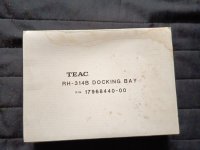famicomaster2
Experienced Member
Hello again, this will be my third post about my little hard disk collection. This group is not nearly as large as the Kalok Octagon collection or the Computer Memories collection, but I feel it is still worthy of it's own little post, as these drives in working condition are rather uncommon, and it's even less likely to find them all in one place side-by-side like this.
From left to right:
Kalok P3-250AR
TEAC SD-3360N
JTS Palladium P1000
JTS Champion C2500
JTS Champion C4300

The design for the Kalok P3/P5 cartridge system shows up around 1992 or 1993 and continues through to the end of Kalok's business in 1994. During that time, the cartridge system was called P3, P5, K-STOR, and was licensed to TEAC who sold it under their brand as "TEAC-STOR." In 1994, Kalok shut their doors and most of their assets were purchased by the JT Storage company, who immediately ditched Kalok's Octagon II line of bottom-dollar stepper actuated hard disks, but kept the cartridge system alive. The drives were given a slightly different controller to break out the regular Molex power and IDE connectors, as well as the configuration jumpers. To make the drives the correct height, as the cartridges are "Ultra Slim" at 0.25" tall, JTS used spindly little metal angle brackets on the bottom, affixed with torx screws. It looks as bad as you're imagining. These drives were sold as the CHAMP and Palladium drives, of which you can see the P1000 here. These drive are essentially unchanged from the Kalok units. The later Champion drives, like the C2500 and C4300 on the right have a different bottom half of the chassis, with a structural reinforcements, real cast mounts, and room for a deeper spindle to facilitate the addition of extra platters.
Kalok and by proxy TEAC sold their cartridges in sizes of 250MB, 360MB, and 540MB (P3-250AR, P3-360AR, P3-540AR, SD-3250N, SD-3360N, SD-3540N). It's clear that Kalok was working on drives of at least 1GB as within months of the JTS buyout, the CHAMP C1000 and Palladium P1000 become available.
I've heard rumors both that these Kalok cartridges were intended to replace the Octagon II later on as their own standalone drives, and that they were simply meant to become a higher option to Octagon II drives, and that Kalok was working on further stretching that age-old design. I think that would have been an interesting future - If Kalok could have kept their doors open another year or two, or if JTS hadn't shelved the Octagon II immediately, would we have 240MB, 360MB, 500MB stepper drives? The much more modern but more expensive and worse performing Daeyoung DX-3120A adds an interesting page to this story - The density was obviously continuing to go up, using this technology, it would have been totally plausible to get a 240MB drive in the 3.5x1" form factor, even in 1994.
Anyways, that's just my tinfoil hat theory on old hard drives.
Hope you learned something or at least enjoyed. Questions, comments, concerns are all welcomed and encouraged. Thanks for reading!
From left to right:
Kalok P3-250AR
TEAC SD-3360N
JTS Palladium P1000
JTS Champion C2500
JTS Champion C4300

The design for the Kalok P3/P5 cartridge system shows up around 1992 or 1993 and continues through to the end of Kalok's business in 1994. During that time, the cartridge system was called P3, P5, K-STOR, and was licensed to TEAC who sold it under their brand as "TEAC-STOR." In 1994, Kalok shut their doors and most of their assets were purchased by the JT Storage company, who immediately ditched Kalok's Octagon II line of bottom-dollar stepper actuated hard disks, but kept the cartridge system alive. The drives were given a slightly different controller to break out the regular Molex power and IDE connectors, as well as the configuration jumpers. To make the drives the correct height, as the cartridges are "Ultra Slim" at 0.25" tall, JTS used spindly little metal angle brackets on the bottom, affixed with torx screws. It looks as bad as you're imagining. These drives were sold as the CHAMP and Palladium drives, of which you can see the P1000 here. These drive are essentially unchanged from the Kalok units. The later Champion drives, like the C2500 and C4300 on the right have a different bottom half of the chassis, with a structural reinforcements, real cast mounts, and room for a deeper spindle to facilitate the addition of extra platters.
Kalok and by proxy TEAC sold their cartridges in sizes of 250MB, 360MB, and 540MB (P3-250AR, P3-360AR, P3-540AR, SD-3250N, SD-3360N, SD-3540N). It's clear that Kalok was working on drives of at least 1GB as within months of the JTS buyout, the CHAMP C1000 and Palladium P1000 become available.
I've heard rumors both that these Kalok cartridges were intended to replace the Octagon II later on as their own standalone drives, and that they were simply meant to become a higher option to Octagon II drives, and that Kalok was working on further stretching that age-old design. I think that would have been an interesting future - If Kalok could have kept their doors open another year or two, or if JTS hadn't shelved the Octagon II immediately, would we have 240MB, 360MB, 500MB stepper drives? The much more modern but more expensive and worse performing Daeyoung DX-3120A adds an interesting page to this story - The density was obviously continuing to go up, using this technology, it would have been totally plausible to get a 240MB drive in the 3.5x1" form factor, even in 1994.
Anyways, that's just my tinfoil hat theory on old hard drives.
Hope you learned something or at least enjoyed. Questions, comments, concerns are all welcomed and encouraged. Thanks for reading!








